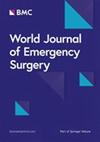High platelet-to-red blood cell ratio and outcomes in trauma patients requiring massive transfusions
IF 5.8
1区 医学
Q1 EMERGENCY MEDICINE
引用次数: 0
Abstract
Uncontrolled bleeding contributes to 40% of trauma deaths. While higher platelet-to-red blood cell (PLT/RBC) transfusion ratios may improve outcomes, the optimal ratio remains unclear. This study aimed to determine the threshold of PLT/RBC ratio and its impact on in-hospital mortality in trauma patients requiring massive transfusions. This retrospective, multicenter study used 2014–2018 National Trauma Database (NTDB) data. Adult patients admitted to Level I/II trauma centers with massive transfusions within 24 h of emergency department (ED) admission were included. Patients were divided into high-PLT group (PLT/RBC ratio > 0.7) and low-PLT group (ratio ≤ 0.7). Primary outcomes: 24-hour and 30-day mortality; secondary outcomes: transfusion-related adverse events. Among 9,330 patients (median age 37 (26–54) years; 78.9% male), 46.1% had a high PLT/RBC ratio. Restricted cubic spline analysis revealed a nonlinear relationship: mortality dropped significantly at > 0.7 and stabilized above 1.5. After inverse probability treatment weighting, the high-PLT group showed lower 24-hour mortality (OR, 0.45; 95% CI, 0.42–0.48) and 30-day mortality (OR, 0.66; 95% CI, 0.62–0.70). However, the high ratio group experienced higher rates of adverse events, including pulmonary embolism, acute kidney injury, and sepsis. Subgroup analyses confirmed consistent survival benefits despite increased adverse events. Sensitivity analysis further supported the robustness of these findings. In this multicenter study, a high PLT/RBC ratio (> 0.7) was associated with improved survival in trauma patients requiring massive transfusions, reducing 24-hour and 30-day mortality. However, it also increased the risk of adverse events, with a ceiling effect observed at ratios above 1.5. These findings underscore the need for high-quality clinical trials to validate the benefits of high PLT/RBC ratios and optimize transfusion strategies for trauma patients.需要大量输血的创伤患者的高血小板/红细胞比率和预后
不受控制的出血导致40%的外伤死亡。虽然更高的血小板与红细胞(PLT/RBC)输血比例可能改善预后,但最佳比例仍不清楚。本研究旨在确定PLT/RBC比值阈值及其对需要大量输血的创伤患者住院死亡率的影响。这项回顾性的多中心研究使用了2014-2018年国家创伤数据库(NTDB)的数据。在急诊室(ED)入院后24小时内大量输血的I/II级创伤中心的成年患者被纳入研究对象。将患者分为高血小板组(血小板/红细胞比值bb0 0.7)和低血小板组(血小板/红细胞比值≤0.7)。主要结局:24小时和30天死亡率;次要结局:输血相关不良事件。在9330例患者中(中位年龄37(26-54)岁;78.9%男性),46.1%的患者PLT/RBC比值较高。限制三次样条分析显示出非线性关系:死亡率在>.7时显著下降,在1.5以上稳定。经反概率加权治疗后,高plt组24小时死亡率(OR, 0.45; 95% CI, 0.42-0.48)和30天死亡率(OR, 0.66; 95% CI, 0.62-0.70)较低。然而,高比例组的不良事件发生率更高,包括肺栓塞、急性肾损伤和败血症。亚组分析证实,尽管不良事件增加,但生存获益一致。敏感性分析进一步支持了这些发现的稳健性。在这项多中心研究中,高PLT/RBC比率(>.7)与需要大量输血的创伤患者的生存率提高相关,降低24小时和30天死亡率。然而,它也增加了不良事件的风险,在比率超过1.5时观察到天花板效应。这些发现强调需要高质量的临床试验来验证高血小板/红细胞比率的益处,并优化创伤患者的输血策略。
本文章由计算机程序翻译,如有差异,请以英文原文为准。
求助全文
约1分钟内获得全文
求助全文
来源期刊

World Journal of Emergency Surgery
EMERGENCY MEDICINE-SURGERY
CiteScore
14.50
自引率
5.00%
发文量
60
审稿时长
10 weeks
期刊介绍:
The World Journal of Emergency Surgery is an open access, peer-reviewed journal covering all facets of clinical and basic research in traumatic and non-traumatic emergency surgery and related fields. Topics include emergency surgery, acute care surgery, trauma surgery, intensive care, trauma management, and resuscitation, among others.
 求助内容:
求助内容: 应助结果提醒方式:
应助结果提醒方式:


